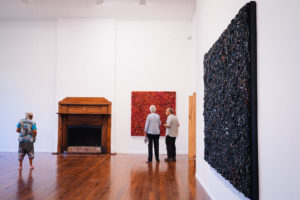A few years ago, entering a small corner room in a museum in Italy, I found a visitor dragging his fingernails down the surface of a painting by Agostino Bonalumi. Measuring its hills and valleys, leaving little pale stripes of scuffed paint behind him, the visitor turned around with a shocked look on his face as he heard me approaching, and quickly marched for the exit. In his walce I was left with mixed feelings of horror and envy. An echo of this transgressive desire — to enter the intimate haptic world of the art object — returned powerfully during recent viewings of Dani Marti’s ‘Black Sun’ and Bharti Kher’s ‘In Her Own Language’, both in the program of this year’s Perth International Arts Festival.
 Hosted by the Fremantle Arts Centre (FAC), ‘Black sun’ was Marti’s first Western Australian solo exhibition, a profile of work executed since 2007. During this period, the Spanish-born artist has developed a distinctive practice combining video art and textiles. file the latter predominates numerically, Marti’s concerns are explored most directly through the camera. In this case, at the symbolic heart of the exhibition was a video documenting his intimate relationship with a blind man called Bob. In Notes for Bob (Embrace) (2015), Bob rests in his apartment, in his underwear, in Marti’s lap. They grasp at one another, and though it’s dark and difficult to see, the listener’s ears fill with sound of skin moving over skin.
Hosted by the Fremantle Arts Centre (FAC), ‘Black sun’ was Marti’s first Western Australian solo exhibition, a profile of work executed since 2007. During this period, the Spanish-born artist has developed a distinctive practice combining video art and textiles. file the latter predominates numerically, Marti’s concerns are explored most directly through the camera. In this case, at the symbolic heart of the exhibition was a video documenting his intimate relationship with a blind man called Bob. In Notes for Bob (Embrace) (2015), Bob rests in his apartment, in his underwear, in Marti’s lap. They grasp at one another, and though it’s dark and difficult to see, the listener’s ears fill with sound of skin moving over skin.
Textiles and other wall-based constructions are an extended meditation on the relationship between feeling and looking, touching and seeing, closeness and distance. Prelude (2015), a tangle of moulded corner cube reflectors drawn together into a gigantic bulging circle, threatened to engulf the viewer. It appeared a weird glittering orb of plastic, growing outwards in every direction. This sense of indefinite expansion was reprised to dramatic effect in big flat squares and rectangles covered in women’s jewellery, often in one or two colours only. Made to rest against the body, it was di Cult to look at these objects without imagining how they would feel pressed to your skin.
If the intimate closed spaces of FAC often forced viewers into proximity with Marti’s work, the wide open rooms of the Lawrence Wilson Art Gallery allow for a comfortable distance when encountering Kher’s ‘In Her Own Language’. Although her shares Marti’s emphasis on tactility, her art also demands to be considered at a remove. Works such as Cell (2013) and Dark Matter (MM) (2015) immediately bring to mind the broad level forms of mid-century abstraction, a connection which curator Margaret Moore acknowledges in her exhibition catalogue. Moving closer, these flat images resolve into a complex three- dimensional field of raised lumps and swellings — bindis stuck one on top of the other to a painted board.
The bindi, along with other signs of a very recognisable and familiar Indianness, is a recurring motif in Kher’s work. Her ‘portraits’, for example, are a series of sculptures made by coat- ing saris in resin and leaving them to dry, draped and knotted around columns of concrete. Portrait Meera (2013) stands up as though acknowledging the viewer; each has its own strange anthropomorphic character. Rice, another icon of the subcontinent, appears in Sing to them th it will listen (2008). Here, Kher has inscribed hundreds of rice grains with words in tiny letters, supposedly drawn from the matrimonial column of an Indian newspaper, and placed them in a Tibetan ‘singing bowl’.
Both Marti and Kher have been successful because they effectively synergise a range of ideas current in art today, such as the recovery of sensation against the tyranny of reason. At the same time, they have introduced aspects of their personal experience, like Kher’s Indian heritage or Marti’s moments of intimacy. But when is this synergy no longer an achievement? When does an artist’s return to subjectivity become an escape from the real? In the introduction to Homi K. Bhabha’s landmark theoretical text The Location of Culture (Routledge, 1994), the author explains that the exchange of ideas between people, cultures and traditions ‘may not always be collaborative and dialogical, but may be profoundly antagonistic, conflictual and even incommensurable’. If Marti’s textiles and Her’s diverse creations are often evocative, richly sensual and impressively constructed, they are rarely challenging, difficult or critical. In blending the signs and orders of global contemporary art, modernist painting, sexual experience and Indian religion, there is an obligation to think and reflect about how these fit together. Not sufficiently recognised or addressed, in both cases this obligation remains to be acknowledged.